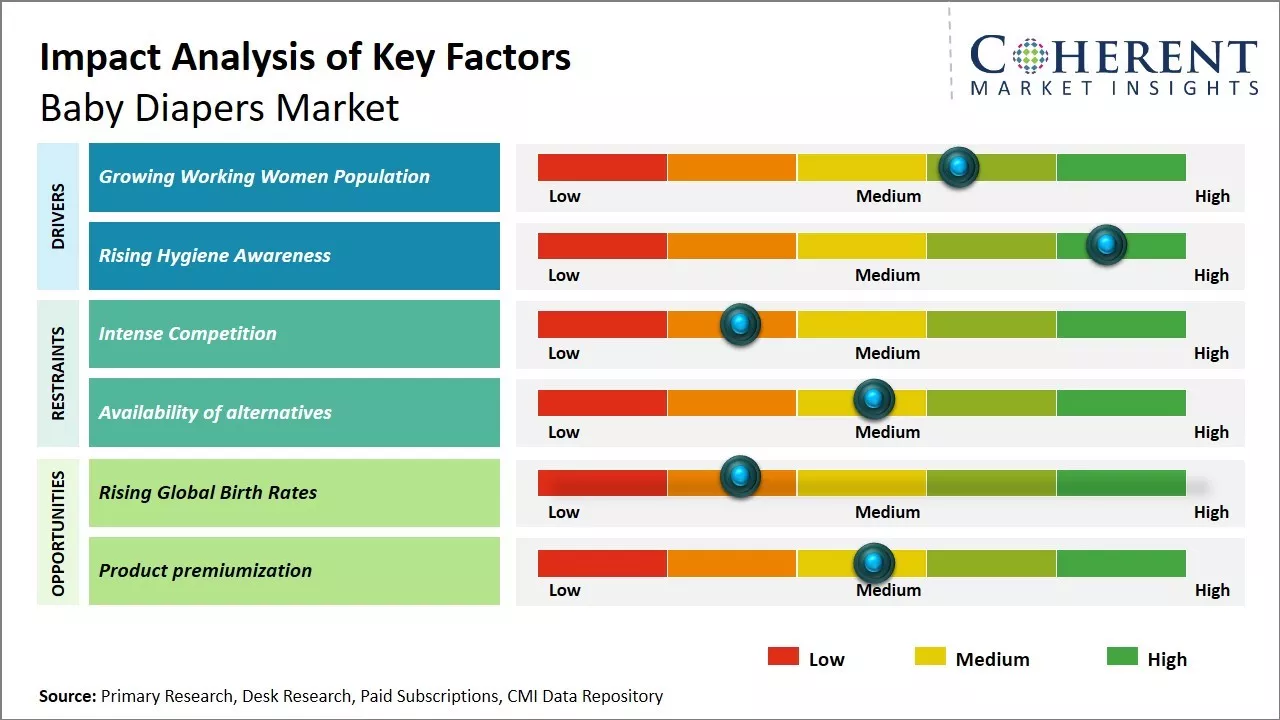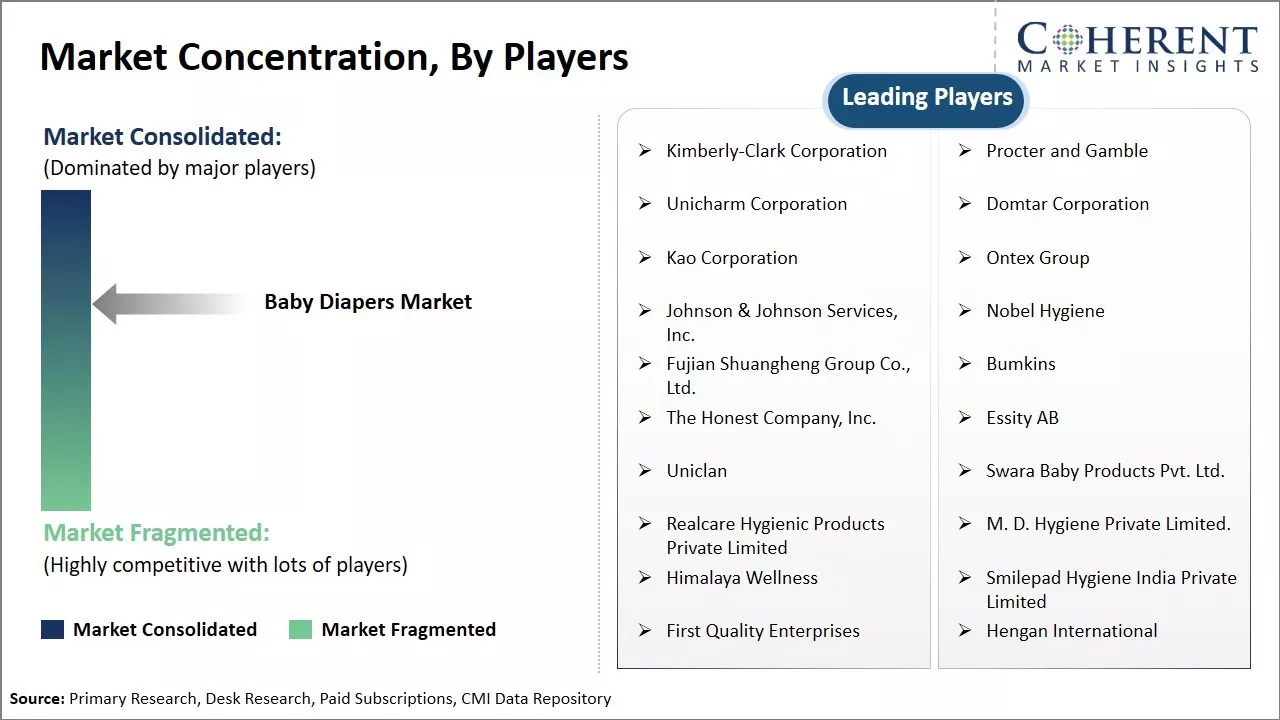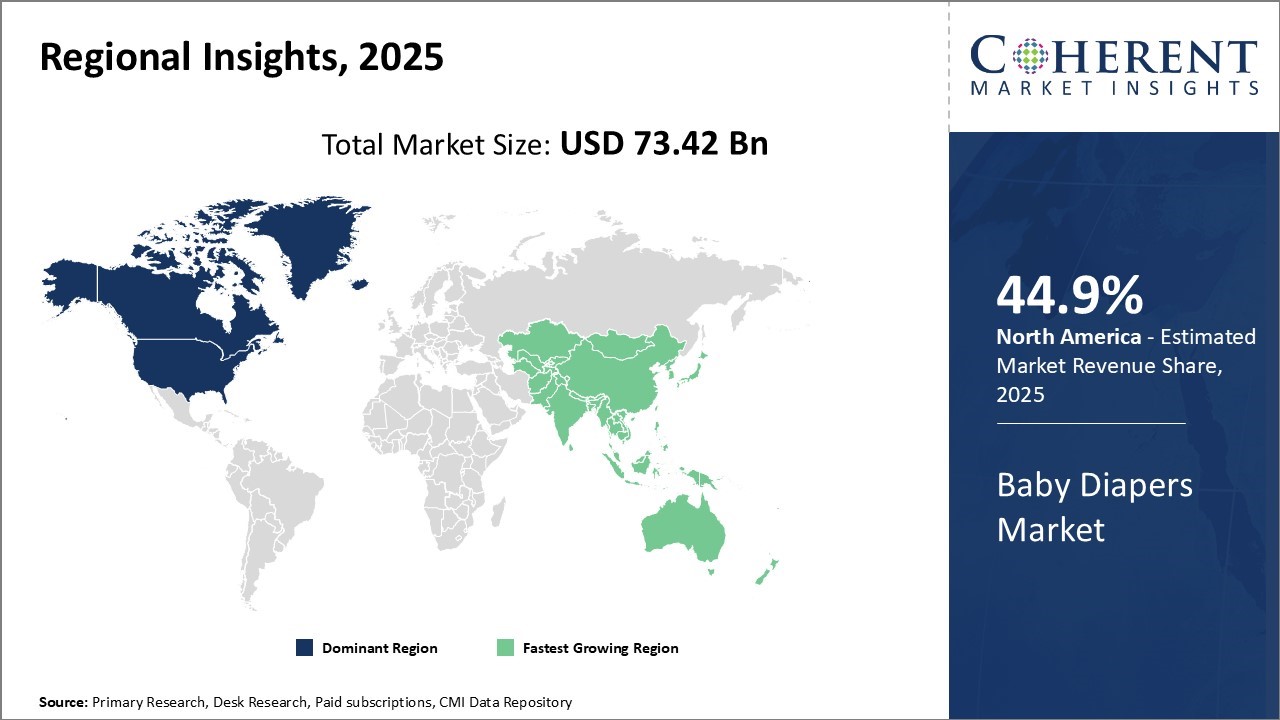The baby diapers market is estimated to be valued at USD 73.42 Bn in 2025 and is expected to reach USD 102.69 Bn by 2032, exhibiting a compound annual growth rate (CAGR) of 4.9% from 2025 to 2032.

To learn more about this report, Download Free Sample
The demand for baby diapers is expected to rise continuously during the forecast period. Changing lifestyles and rising disposable incomes are factors boosting demand. Parents are willing to spend more on high-quality baby hygiene products for comfort and convenience. Innovation in terms of breathability, absorption, and skin-friendliness is further driving the market growth.
However, one of the key challenges faced by players in the baby diapers market is intense competition.

To learn more about this report, Download Free Sample
|
Current Events |
Description and its impact |
|
Geopolitical Supply Chain Disruptions |
|
|
Regulatory Shifts in Sustainability |
|
Uncover macros and micros vetted on 75+ parameters: Get instant access to report
The increasing preference for natural and organic diaper materials is fundamentally reshaping the baby diapers market, acting as a primary catalyst for its expansion. This shift stems from heightened environmental consciousness among modern parents, particularly millennials, who are increasingly aware of the ecological toll of traditional disposable diapers.
For instance, Cottonsie introduced a plant-based disposable diaper, designed to offer both sustainability and high performance. The new diaper will replace conventional plastic components with 100% breathable cotton in key layers, including the top sheet, back sheet, acquisition distribution layer (ADL), and core wrap.
In terms of product type, disposable diapers contribute the an estimated 61.6% share of the market, owing to its convenience and affordable price point compared to non-disposable options.
Being single-use, disposable diapers allow parents and caregivers to simply dispose of soiled diapers without the hassle of washing and drying cloth versions. This makes disposable diapers very attractive for on-the-go families as well as those with young infants who go through many diaper changes per day. The convenience of disposable diapers means less time spent on diaper-related chores and more time that can be spent focusing on baby care or other tasks.
In terms of style, pant style is expected to contribute 61.6% share of the market, due to the ease of use it offers parents and caregivers. Pant style diapers resemble regular underpants with elastic leg openings but are designed to contain messes.
Unlike tape style diapers which require precise closing of multiple tapes or tabs, pant style simply pulls on like regular underwear. This makes them quicker and simpler to put on babies, especially crawling or walking toddlers who are prone to squirming during diaper changes. The pant style is also convenient when dressing wriggly infants outdoors or in public places as it reduces the fuss of ensuring multiple seals are properly in place.
In terms of distribution channel, the offline segment is projected to contribute 62.1% share, due to wide availability and discoverability. Local supermarkets, drugstores, and baby goods retailers all stock disposable diapers on their shelves. This makes diapers immediately available whenever parents find themselves in need without a delivery delay.
In terms of distribution channel, the offline channel contributes the 62.1% share due to wide availability and discoverability. Local supermarkets, drugstores, and baby goods retailers all stock disposable diapers on their shelves. This makes diapers immediately available whenever parents find themselves in need without a delivery delay.
By integrating AI into product design, manufacturing, and consumer engagement, companies are redefining how diapers are developed and used, ultimately enhancing performance and customer satisfaction.

To learn more about this report, Download Free Sample
The North American region currently dominates the global baby diapers market with an estimated 44.9%, led primarily by the U.S. With a high birth rate and growing working women population, the demand for convenient and absorbent disposable diapers has been rising steadily over the past decade.
For instance, as per the Healthy Children.Org, it is estimated that most U.S. parents go through nearly 3,000 diapers during their baby's first year alone and average six diaper changes a day for an estimated total of 8,000 over the course of a baby's diaper-wearing career.
The Asia Pacific region is emerging as the fastest growing market for baby diapers globally. China represents a massive untapped opportunity with one of the largest newborn populations worldwide. Although the penetration of disposable diapers in China remains lower than in developed countries, rising income levels, urbanization, and changing lifestyles are increasing the demand for convenient childcare products.
According to the United Nations International Children's Emergency Fund (UNICEF), China had the world’s second-largest child population in 2021, accounting for 12.5% of the global total. This demographic trend further underscores the growth potential for baby care products in the country.
American parents increasingly demand diapers that offer superior comfort, skin protection, and hygiene, such as moisture-wicking layers, leak barriers, and breathable fabrics. Convenience is central, with many turning to subscription services or direct delivery options for ease of use. Eco-conscious consumers are also gravitating toward plant-based or compostable versions that reduce environmental impact while maintaining performance.
In Germany, there is a strong emphasis on dermatological safety and sustainable materials; parents often seek fragrance-free or biodegradable diapers made from natural fibers. Cultural values around environmental responsibility and sensitive skin drive preference for products that are both skin- and planet-friendly. Cloth diapering communities and composting initiatives further reinforce awareness and product innovation in this space.
Urban Chinese families are showing growing interest in sleek, ultra-thin diapers that incorporate advanced features like absorbency enhancers, plant extracts for skin health, and even early-stage smart diaper designs. Many parents’ link diaper choice to hygiene and trust established foreign or premium brands. This shift reflects evolving lifestyle values and increased attention to child care quality in cities.
In India, urban caregivers—especially in metro areas—are increasingly choosing disposable diapers over traditional cloth due to rising convenience expectations and hygiene awareness. Working mothers and dual-income households favor readily available branded products, often purchased via evolving e‑commerce access and store networks. As awareness of infant care and hygiene grows, so does trust in disposable diaper formats for daily use.
| Report Coverage | Details | ||
|---|---|---|---|
| Base Year: | 2024 | Market Size in 2025: | USD 73.42 Bn |
| Historical Data for: | 2020 To 2024 | Forecast Period: | 2025 To 2032 |
| Forecast Period 2025 to 2032 CAGR: | 4.9% | 2032 Value Projection: | USD 102.69 Bn |
| Geographies covered: |
|
||
| Segments covered: |
|
||
| Companies covered: |
Kimberly-Clark Corporation, Procter and Gamble, Unicharm Corporation, Domtar Corporation, Kao Corporation, Ontex Group, Johnson & Johnson Services, Inc., Nobel Hygiene, Fujian Shuangheng Group Co., Ltd., Bumkins, The Honest Company, Inc., Essity AB, Uniclan, Swara Baby Products Pvt. Ltd., Realcare Hygienic Products Private Limited, M. D. Hygiene Private Limited., Himalaya Wellness, Smilepad Hygiene India Private Limited, First Quality Enterprises, and Hengan International |
||
| Growth Drivers: |
|
||
| Restraints & Challenges: |
|
||
Uncover macros and micros vetted on 75+ parameters: Get instant access to report
*Definition: The baby diapers market caters to babies and toddlers between birth and 3 years of age. It includes various types of diapers like cloth diapers, disposable diapers, swimming diapers, biodegradable diapers, training pants, etc. made from materials such as cotton, microfiber, bamboo, organic cotton, etc., offering different levels of absorbency. Major players in this market manufacture diapers using modern technologies and sell them through multiple online and offline retail channels to be used by parents and caregivers.
Share
Share
Missing comfort of reading report in your local language? Find your preferred language :
Transform your Strategy with Exclusive Trending Reports :
Frequently Asked Questions
Joining thousands of companies around the world committed to making the Excellent Business Solutions.
View All Our Clients